Bosnian Food Dishes: Basic Overview
Common Ingredients
Common Cooking Methods
Courses
Meals
Key Taste
Eating Etiquette
Meal Presentation
Culinary Festivals
Influence and Fusion
Popular Types of Bosnian Dishes
-
Grilled and Barbecued Dishes
Bosnia and Herzegovina cuisine features many grilled dishes based on minced and spiced meat.
Halal meats like beef, lamb, and chicken are used to conform to Islamic dietary laws, though non-Muslims sometimes prepare grilled dishes with pork.
Bosnian grilled dishes are commonly served with flatbread as a combo for entrees and street food.
-
Stews
Bosnian stews are very savory and rich in ingredients.
These dishes are often made with meat, beans, various vegetables, and a moderate amount of spices.
Certain stews are highly comforting and nourishing since they are prepared as winter staples.
-
Desserts
Desserts in Bosnia and Herzegovina are mostly sweet and creamy.
Many of these treats hail from Ottoman cuisine and are popular during Islamic holidays.
Bosnian desserts come in many textures, depending on the varieties, which range from pastries to fruit-based treats.
Bosnian dishes are the specialties prepared in Bosnia and Herzegovina, a country in the Balkans. These dishes are officially known as Bosnia and Herzegovina dishes, but most people just call them Bosnian dishes.
As Bosnia and Herzegovina lies in an important position, its history has experienced many significant events and developments that significantly enriched local dishes.
Bosnian dishes are strongly influenced by neighboring Balkan countries, the Austro-Hungarian tradition, and Turkish culinary delights (Ottoman). Local food offerings are often rich, nourishing, and suitable for the season.
I will offer more details about traditional Bosnian food, such as its principal characteristics, global popularity, and health values.
Next, I will describe the 17 most popular dishes from Bosnia and Herzegovina, followed by two sections on what makes Bosnian dishes special and what to pair with local food.
17 Mind-blowing Bosnian Dishes
The 17 best examples of Bosnian dishes are waiting for you to explore. Use advanced filters to navigate this content more easily; there are options regarding alphabetical sorting, main ingredients, taste, cooking methods, dish types, courses, and global popularity.
Don’t forget to check out the additional filters based on specific culinary styles, such as traditional, national, street food, fusion, exotic, and vegetarian options.
Ćevapi
- National
- Street Food
- Traditional
Ćevapi is a Bosnian grilled dish prepared with minced and seasoned beef or mutton, or a mix of both. The meat is shaped into a long, sausage-like shape the size of a finger.
Ćevapi is flavorful enough to enjoy on its own, but locals often enjoy it with somun (a type of flatbread), kajmak (local cream cheese), and raw onions.
Turkish kebab is the main inspiration for ćevapi, which is well-known throughout the Balkans. Different regions of Bosnia have their own ways of preparing this grilled dish.
In Banja Luka, Bosnia and Herzegovina’s second-largest city, ćevapi has four sausages connected together. Meanwhile, Travik-style ćevapi is brushed with a meaty broth before being grilled.
Börek
- National
- Street Food
- Traditional
Börek, also known as burek, is a popular pastry made from minced meat in Bosnia and Herzegovina. It is a classic dish in Ottoman cuisine and is known in many countries, from the Balkans to the Middle East.
To prepare börek, people roll out a flaky dough and fill it evenly with savory ingredients, then they roll the stuffed dough and bake or fry it. Minced meat, cheese, spinach, and vegetables are popular fillings.
Börek is a sought-after Bosnian street food, breakfast dish, and lunch snack. Pita is a type of pastry similar to börek, but it has no meat and is usually filled with cheese.
Bosanski Lonac
- National
- Traditional
Bosanski lonac, literally “Bosnian pot,” is a hearty Bosnian dish with alternating layers of meat chunks and roughly cut vegetables that are slowly cooked in their own juice.
Beef, tomatoes, cabbages, carrots, and potatoes are common ingredients for the Bosnian pot. The traditional version is prepared in an earthen or ceramic pot over a fire pit.
People usually serve the Bosnian pot with bread to best enjoy its fatty, savory nature. The amount of meat and the value of vegetables in the pot is a sign of status: rich Bosnians add more meat and use higher-priced greens.
Ružice
- Traditional
Ružice is the Bosnian version of baklava, a globally popular pastry dessert in Ottoman cuisine. Its main ingredient is filo (or phyllo), a very thin unleavened dough.
Ružice consists of many paper-thin filo sheets rolling around a mixture of chopped walnuts or pistachios and sugar syrup or honey. After baking, the pastries are soaked in a fragrant syrup, giving them a sweet, moist texture that contrasts with the crispy layers of filo.
Literally “little roses,” ružice should have a rose-like appearance when sliced and served. Its sweet flavor goes well with local coffee.
Sarma
- Traditional
Sarma is a common stuffed dish in Bosnia and Herzegovina. Derived from Ottoman cuisine, it is also well-known in many countries in the Balkans and the Middle East.
Sarma consists of cabbage leaves or vine leaves stuffed with a savory mixture of minced meat, rice, onions, and spices. The rolls are tightly packed in a pot and simmered in a tangy broth (usually based on tomatoes).
This stuffed dish is a popular choice for holidays and festivals in Bosnia and Herzegovina, especially during Ramadan. Dolma is a similar dish to sarma, but it features juicy vegetables like bell peppers and onions.
Pljeskavica
- Street Food
- Traditional
Pljeskavica is a famous grilled dish and street food staple in Bosnian cuisine. Hailing from Serbia, it consists of meat patties based on ground meat (typically beef and lamb), finely chopped onions, and spices.
Pljeskavica literally means “to clap the hand,” referring to the act of shaping the meat patties. These meat patties are then grilled until they are crispy outside and succulent inside.
Locals often sandwich pljeskavica between two slices of flatbread like a burger and serve it with raw onions, salads, kajmak, and sauces. Another way is to serve the grilled meat patty on a plate with fries or salads.
Begova Corba
- Traditional
Begova corba is a renowned Bosnian soup consisting of chicken or meat, spices, carrots, celery, potatoes, and many other vegetables. People cook the soup slowly over low heat and serve it in a clay bowl with sour cream for extra sweetness and creaminess.
Begova corba means “Bey’s soup,” with bey being a Turkic title for chieftain or governor in charge of a province or district in the Ottoman Empire. This rich soup is a winter staple strongly associated with the Bosnian capital city of Sarajevo.
Suho Meso
- Traditional
Suho meso, literally “dried meat,” is a traditional Bosnian dish known for its smoky, savory flavor and chewy texture. Locals prepare it by salting chunks of pork, beef, or lamb before drying and smoking them.
Dating back to ancient times, suho meso was historically an important source of protein during winter times. Bosnian dried meat goes well with starch foods, vegetables, and beer.
Prebranac (Pasulj)
- Traditional
Prebranac, also known as pasulj, is an inexpensive bean dish in Bosnia and Herzegovina and many Balkan countries.
True to its simple and rustic roots, prebranac doesn’t take much to prepare. People simply boil beans, caramelize onions, and bake these ingredients with herbs for flavoring.
In the past, prebranac was one of the dishes that helped Bosnia peasants survive the harsh winter. Nowadays, it is a perfect comfort food to serve with bread.
Somun
- Traditional
Somun is a widely enjoyed flatbread in Bosnia and Herzegovina. Derived from Ottoman cuisine, it is made from water, flour, and yeast and traditionally baked in a wood-fired oven.
Bosnians typically serve somon alongside ćevapi, stews, and sauces. Its fluffy texture makes this bread ideal for sopping up the rich sauce.
Somun is quite similar to pita bread, a famous yeast-raised flatbread in the Middle East and the Mediterranean, but it is softer.
Speaking of popular Bosnian flatbread, lepinja is a local flatbread that is almost identical to somun. Foreign tourists have difficulties telling the two apart, but locals rarely encounter the same mishap.
Djuveč
- Traditional
Djuveč is the Bosnian take on ghivetch, a classic vegetable stew well-known throughout the Balkans. Its name was derived from “güveç,” a Turkish word meaning “earthen pot”
To prepare djuveč, locals cook various vegetables, such as peas, tomatoes, peppers, onions, and carrots, with herbs and spices in a güveç. Aromatic rice is usually the best accompaniment for this stew.
Although traditional djuveč is a vegan dish, there is nothing wrong with adding chicken, lamb, or beef to increase its nutritional value.
Ustipci
- Street Food
- Traditional
Ustipci is a famous fried dough treat that is easy to find in Bosnia and Herzegovina and throughout the Balkans. Its main ingredients include flour, water or milk, and yeast.
The preparation of ustipci involves deep-frying the dough until it archives a golden, crispy exterior and soft, airy interior.
Bosnians usually serve ustipci hot with various spreads, kajmak, ajvar (a red pepper-based condiment), sugar, honey, or fruit jam.
Tufahije
- Traditional
Tufahije, literally “apple.” is a Bosnian apple-based dessert of Ottoman origin. Locals prepare it by coring apples, stuffing them with a sweetened mixture of walnuts, and poaching them in a sugar syrup flavored with lemon or cinnamon.
Tufahije is typically served chilled, often with a dollop of whipped cream on top. The soft, sweetened apples contrast beautifully with the crunchy, nutty filling, and arranging them in a transparent glass will improve the visual appeal even further.
Hurmašice
- Traditional
Hurmašica is a type of syrup-drenched cookie or cake that Bosnians usually prepare for important religious holidays. It originated in Ottoman cuisine and is customarily enjoyed with Bosnian coffee.
The first step of making hurmašica is to prepare the dough of flour, butter, sugar, and eggs. The dough is then divided into small logs, which are pressed on a grater to give them their distinct alligator skin-like appearance.
Lastly, people bake and douse hurmašica with lemon-flavored sugar syrup. The cookies are fluffy and spongy, so they will absorb every bit of the syrup, acquiring a deeply sweet and pleasant taste.
Tarhana
- Traditional
Tarhana is a traditional Bosnian soup made with yogurt, fermented dough, ground meat, vegetables, and various spices. The first two ingredients give tarhana its uniquely savory, tangy taste and thick, comforting texture.
While tarhana makes a wonderful Bosnian breakfast dish, it is suitable for other meals as well, especially during the colder month. Originally an Ottoman dish, this tangy soup is now a beloved option for many Bosnian households.
Boranija
- Traditional
Boranija, also spelled as buranija, is a Bosnian stew prepared with Romano beans (or flat beans), which is a type of green beans. Its name also means “green beans” in the local language.
The preparation of boranija involves stewing flat beans with beef or lamb (optional), garlic, vegetables, and spices for hours. When the mixture has a tender texture and a rich aroma, you will have a superb stew to enjoy with bread.
Jabukovača
- Traditional
Jabukovača, often referred to as Bosnian apple pie, is a traditional dessert in Bosnia and Herzegovina. It has a sweet and fruity flavor that goes well with coffee and soft drinks.
Locals prepare jabukovača in a similar manner to baklava, wrapping filo pastry around a filling of chopped apples, sugar, cinnamon, and optional nuts or dried fruits. This dessert is often dusted with powdered sugar or a mixture of honey and lemon juice.
After reading these descriptions, are you now interested in learning about the common traits of Bosnian cuisine? Scroll down for more information.
What Are the Main Characteristics of Bosnia and Herzegovina Cuisine?
Bosnia and Herzegovina cuisine is an incredibly diverse picture; to experience all its amazing flavors, you should learn about the four following aspects.
The long history of Bosnia and Herzegovina is a significant factor that shapes its cuisine. Through trade, conquest, and occupation, local dishes have been strongly influenced by Ottoman, Austro-Hungarian, and Balkan culinary traditions.
Bosnia and Herzegovina has a varied geography that includes fertile plains, mountains, and an Adriatic coastline. This condition contributes to a diverse range of agricultural products, including fruits, vegetables, herbs, and livestock.
The four distinct seasons greatly influence the availability of ingredients, creating many seasonal Bosnian dishes, especially winter delicacies.
In addition, traditional preservation methods, such as drying, smoking, and pickling, are important for storing food over the winter months.
This Balkan country is home to multiple ethnic groups, including Bosniaks, Serbs, and Croats, each with their own culinary traditions.
Additionally, the presence of Islam, Orthodox Christianity, and Catholicism has also influenced dietary laws and food traditions. Dishes for Islamic holidays are especially popular.
While a large proportion of Bosnia and Herzegovina practice Islamism, finding alcoholic beverages in the country is relatively easy, opening up multiple beverages for pairing with local food.
What Beverages to Pair with Dishes in Bosnia and Herzegovina?
The three following beverages are popular options for complementing various dishes in Bosnia and Herzegovina cuisine.
Rakija
Rakija is a strong fruit brandy that is often consumed with savory, hearty dishes in Balkan cuisines, such as ćevapi, pljeskavica, suho meso, and meat-filled börek.
Bosnian Coffee
Traditional Bosnian coffee is rich, strong, and bitter, so it is an ideal accompaniment for sweet treats like ružice, tufahije, jabukovača, and hurmašice.
Wine
Bosnia and Herzegovina is home to several famous red and white wine vintages. These beverages can complement a variety of savory dishes, including Bosanski lonac, djuveč, begova corba, and sarma.
What Bosnian dishes do you want to try? Let me know your thoughts and opinions in the comment section; your feedback is a huge motivator for me! Don’t forget to share this list of Bosnian dishes before checking out other interesting posts.



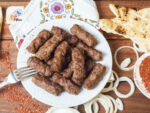
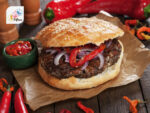
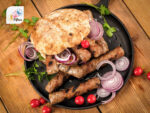
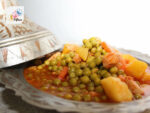

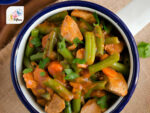


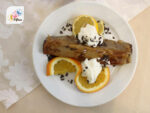
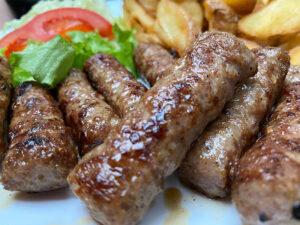
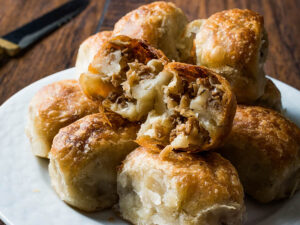
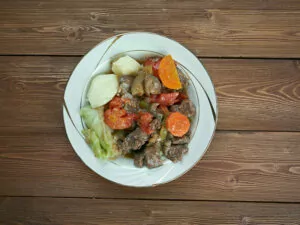
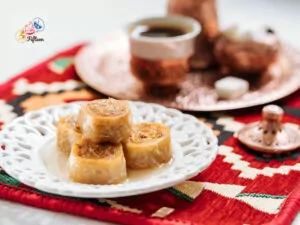
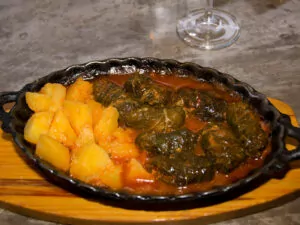

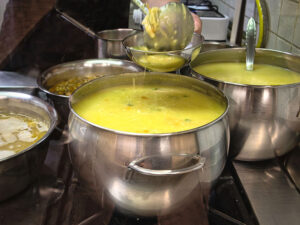
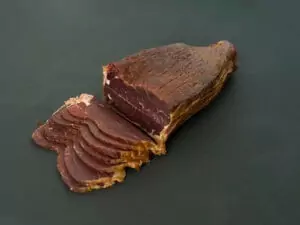
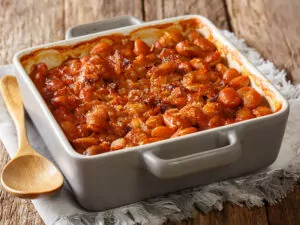
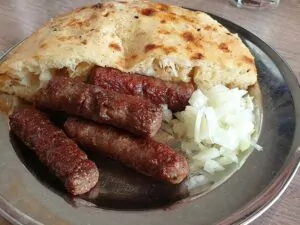
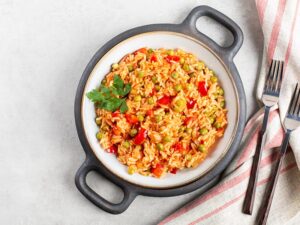
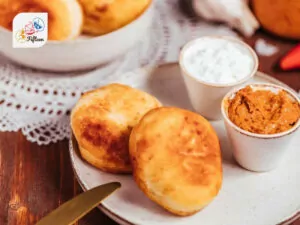
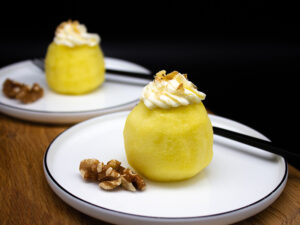
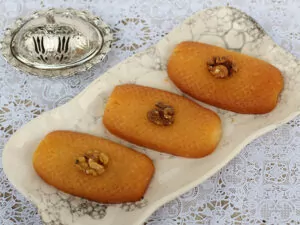
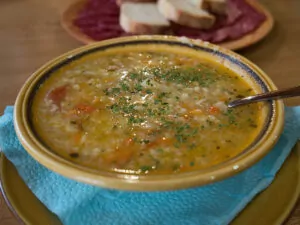
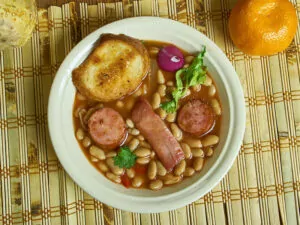
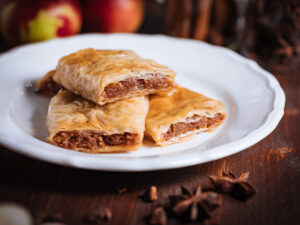
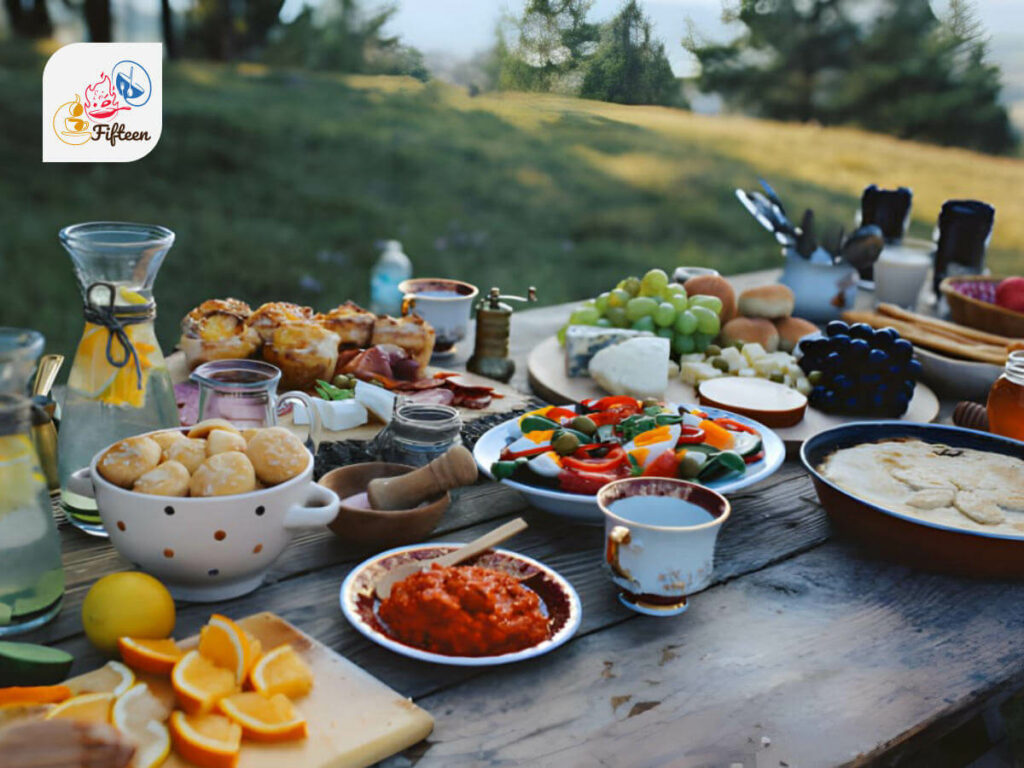
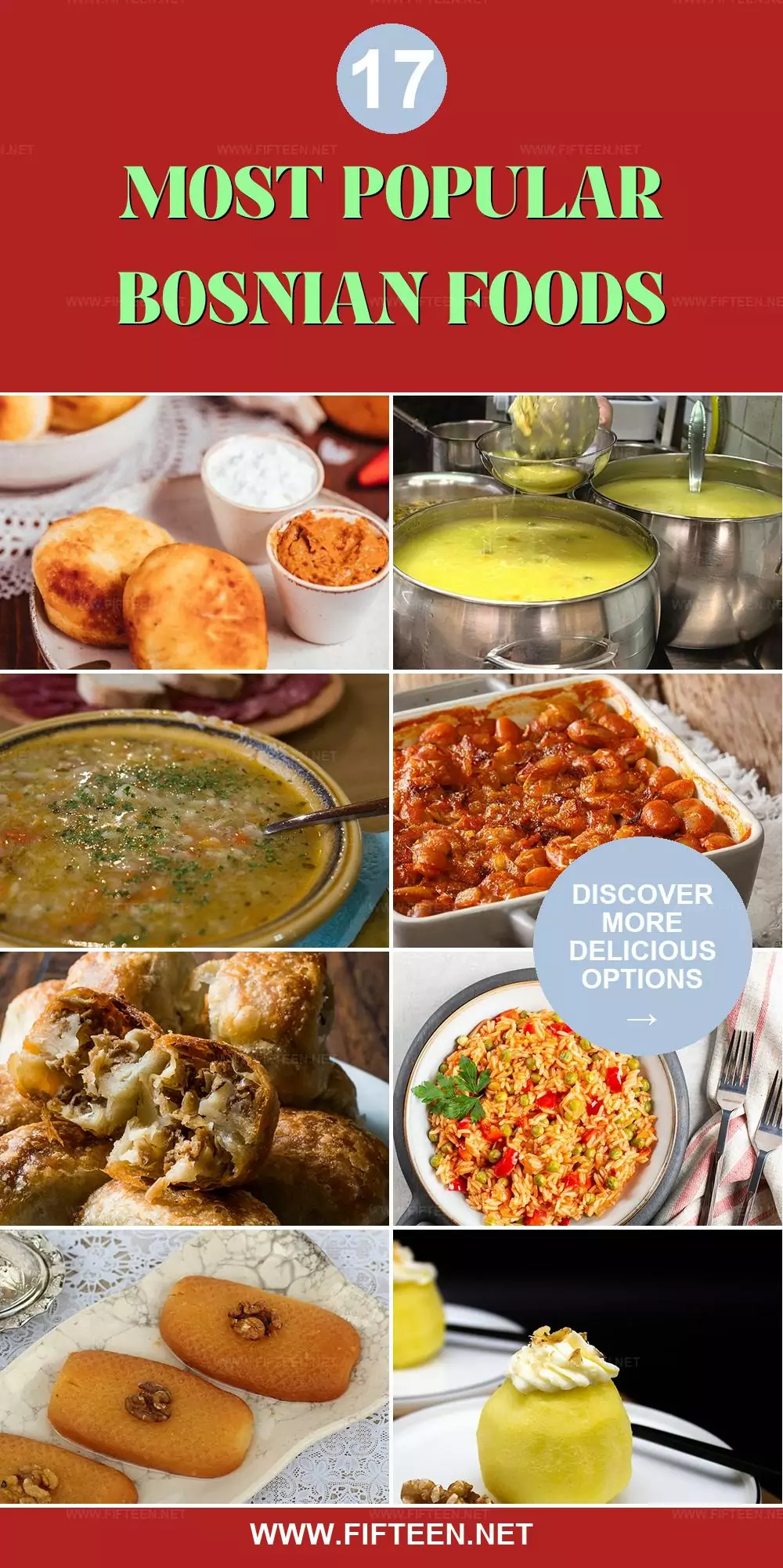
Jamie Scott
Editor in Chief, Senior Content Writer
Expertise
Home Cooking, Meal Planning, Recipe Development, Baking and Pastry, Food Editor, Cooking-video Maker, Western Food Evaluation Expert
Education
Le Cordon Bleu College of Culinary Arts
Local Community College, New York, NY
Jamie Scott is a skilled culinary expert and content creator specializing in Western cuisine. With over 15 years in the culinary field and formal training from Le Cordon Bleu, Paris, Jamie deeply understands how to blend nutrition with delicious flavors. His passion for cooking matches his commitment to making healthy eating accessible and enjoyable.
On Fifteen.net, Jamie brings a fresh perspective to classic dishes and beverages, offering readers insightful recipes, cooking tips, and a fresh view on meal planning that emphasizes taste, health, and simplicity.